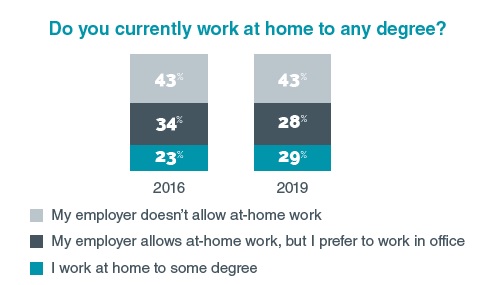Why do people work in offices? The answer to that question used to be obvious — because it’s far easier to communicate and coordinate activities when people are under one roof than when spread apart. The internet has made that answer less clear cut, and perhaps even dated.
Today, in almost any office, what you see are cubicles filled with people facing their computer screens, sometimes with a phone headset on, dutifully clicking and typing, entering data, responding to emails, etc. They are working and communicating electronically — indeed, it’s safe to say that the vast majority of business today is not face-to-face but electronic — and that can be done from anywhere.
So why are workers still going through the inconvenience and expense of long commutes, childcare costs, etc. when they could more comfortably work from home? That’s the question many are asking, including the internal staff of staffing firms.
To learn more about how all this is playing out in the staffing industry, Staffing Industry Analysts recently surveyed nearly 17,000 internal staff of 228 staffing firms regarding work-at-home experiences, with interesting results.
It’s already happening. Currently, 29% of staffing firm internal staff work at home (or remotely) at least some of the time. That’s up from 23% in 2016, when SIA previously surveyed on this question. That share is particularly impressive when considering only about half of staffing firms even allow it.
Increases in working from home were broadly apparent across most staff occupations.
Among those working from home, the average proportion of the workweek performed at home has also increased, to 48% of the time currently from 40% in 2016.
Only experienced need apply. The share of internal staff working from home rises as a function of years of experience in almost all occupations. This is consistent with anecdotal evidence that staffing firms typically become more liberal with work-at-home policies for more seasoned employees.
Sourcing, marketing and recruiting are the functions that ramp up most rapidly in that regard. In particular, among those occupations: with one to five years of experience, 16% to 29% sometimes work from home; with six to 10 years of experience, that range increases to 34% to 50%.
The occupation most notable for high rates of working from home — though less as a function of years of experience — is IT specialist/manager, about half of whom work from home to at least some degree.
It’s a very big deal to employees. Only 10% of internal staff have no interest at all in working from home. More than half of internal staff, 58%, rate the importance of having the option to work from home as either a “five” or “six” on a scale of one to six, with six defined as “the option to work from home is (or would be) a huge benefit.”
Interestingly, staff have greater loyalty to their employer if they are given the work-from-home option, even if they use it only a little or not at all. Among those given the option, net promoter scores (measuring whether they would recommend their firm to a friend or colleague) varied little by how much they used it, ranging from 69% to 79%; among those not given such an option, the net promoter score was 49%.
In all age groups, women value the work-at-home option more highly than men, but the difference is particularly notable during the childbearing and child-raising years of 26 to 55.
Managers tend to value the option less than rank-and-file employees.
Pluses and minuses. Internal staff were also asked about the specific advantages and disadvantages of working from home. The advantages noted by staff were what one might expect: eliminating commute time (a significant thing for many), the ability to deal with family and personal issues without having to take time off, the comforts of home, and the ability to get away from office distractions to focus on particular projects.
Perhaps less obvious were the disadvantages. In some cases, employees who expected to find it easier to focus away from the chatter of the office discovered that home also has its distractions. Technology was also sometimes a challenge, with home-based equipment not fully equal to that found in a more professional setting. But the most common disadvantage noted was the people side of the equation — it’s simply lonelier being at home, and you can lose the mojo of being around a team. Despite the efficiencies of the internet, communication is not always equal to the in-person experience.
How to get it right. In a separate, earlier survey of staffing firm managers, SIA asked about best practices in managing at-home employees.
Managers were in greatest agreement on three points:
- Working from home isn’t for everyone — it’s for self-motivated, independent workers whom you can trust and who start out working in the office.
- It’s important to set expectations and to measure and manage those expectations.
- The lines of communication need to be kept open. Employees should still feel part of the team, and that also means providing the technology needed to support those objectives.
Firms and offices, their dual purpose and destiny. In 1937, economist Ronald Coase asked the simple but penetrating question: Why do firms exist? His answer was that certain costs (transaction costs related to information and enforcement of agreements) were reduced in some cases by operating under centralized management (as opposed to everyone organizing entirely through independent contracts), but that if ever those costs declined, businesses would decentralize through outsourcing. Sure enough, that is what is happening now, with outsourcing booming thanks to lower transaction costs enabled by new technologies and business practices.
Coase might as easily have asked the question: Why do offices exist? The answer would have been the same — to reduce transaction costs related to coordinating production, but that if ever those costs declined, offices would shrink, and employees would work on a more decentralized basis. Well, the internet has certainly reduced the cost of information and coordination, and now offices too are effectively decentralizing.
Even so, people are people, and still need face time, so it’s not likely that everyone will end up working entirely remotely. But given the strong staff preference we observed in our survey for at least having the option to work from home now and then, you can expect it to be coming soon to a staffing office near you … quite possibly very near you.









